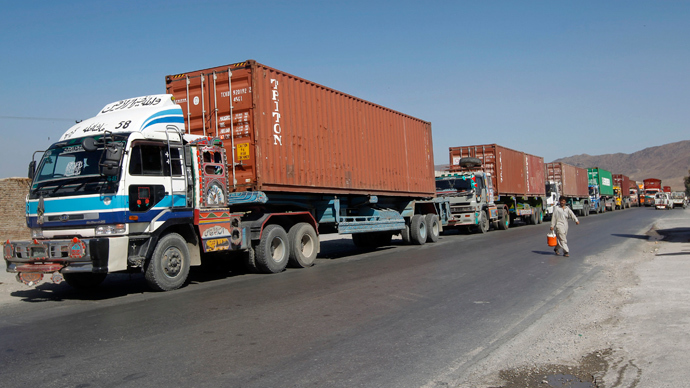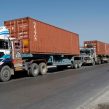
Pakistani Political Turmoil over Drone Strikes Complicates ISAF Afghan Supply Efforts
Publication: Eurasia Daily Monitor Volume: 10 Issue: 224
By:

If all goes as planned, then next year the International Security Assistance Force (ISAF) will begin withdrawing from Afghanistan, completing its departure by the end of 2014. Logistical elements have already begun to be withdrawn by the United States and its Allies. But rising political protests in Pakistan over US drone strikes are complicating truck-based North Atlantic Treaty Organization (NATO) supply lines to and from Pakistan’s Karachi port—forcing the West to increasingly rely on transit routes passing northward through Central Asia and Russia to Europe
The logistical drawdown, which began in September 2012, will see US forces repatriate an estimated 50,000 vehicles, many hardened to make them resistant to mines, along with an estimated 100,000 metal containers (Newsweek Pakistan, November 11). According to Army Brigadier General Duane A. Gamble, the deputy commander of the 1st Theater Sustainment Command, based at Fort Bragg, 70 percent of ISAF’s equipment being withdrawn is being shipped out through Pakistan (American Forces Press Service, October 11).
Pakistan Tehreek-e-Insaf (PTI), Pakistan’s third largest political party, controls the government in Pakistan’s northwestern Khyber Pakhtunkhwa province but sits in opposition in Pakistan’s national parliament. Responding to a call protesting US drone strikes in Pakistan by PTI chairman Imran Khan, beginning on November 24, Tehreek-e-Insaf activists in Khyber Pakhtunkhwa, some armed with clubs, began forcibly searching trucks in an effort to halt NATO resupply efforts for ISAF forces in Afghanistan. They set up five unofficial checkpoints from Torkham to Peshawar, stopping trucks carrying coalition supplies in both directions, threatening drivers and opening containers to check the contents, which include Humvees, military trailers and other non-lethal equipment (PTI press release, November 23).
Pakistani outrage rose dramatically after a Central Intelligence Agency (CIA) drone strike on November 1 killed Tehrik-i-Taliban Pakistan (TTP) leader Hakimullah Mehsud, effectively derailing the efforts of Prime Minister Nawaz Sharif to arrange peace talks with the TTP (https://tribune.com.pk/story/626123/ttp-chief-hakimullah-mehsud-buried/).
On December 3, Pentagon spokesman Mark Wright said that Pentagon military logisticians had decided to stop shipments through the Torkham border crossing because local drivers working for the US military were being threatened by the protesters. Wright said, “We have voluntarily halted U.S. shipments of retrograde cargo through the Pakistan Ground Line of Communication from Torkham Gate through Karachi. We anticipate that we’ll be able to resume our shipments through this route in the near future. While we favor shipping cargo via Pakistan because of cost, we have built flexibility and redundancy into our overall system of air, sea and ground routes to transport cargo into and out of Afghanistan.” The same day, State Department deputy spokeswoman Marie Harf told a press briefing, “We favor shipping cargo via Pakistan because of the cost. And hopefully I don’t anticipate that there will be any long-term impact to our retrograde movement because of the current situation.” The US military still has around 46,000 troops in Afghanistan, a figure set to decline to 34,000 by early 2014 (nation.com.pk, December 5).
The PTI protests in Pakistan’s turbulent northwest add additional complications to the US military’s upcoming withdrawal from Afghanistan over and above Afghan President Hamid Karzai’s confrontation with Washington over whether a residual force of US and allied troops will remain in the country after ISAF’s mandate expires in December 2014. Karzai is refusing to sign the Bilateral Security Agreement required by Washington to set up the legal and operational framework for a post-2014 residual training force of up to 12,000 troops, likely to be mostly American (afghanzariza.com, December 12).
PTI Central Information Secretary Shireen Mazari said that the Pakistani federal government, after Prime Minister Sharif’s October visit to Washington, sacrificed the interests and mandate of the people of Pakistan and the All Party Conference to US interests, commenting, “It has become abundantly clear that the Sharif government has arrived at a covert deal on drones with the US in the same manner as its predecessors” (PTI press release, December 4).
The PTI shutdown is not the first time that ISAF logistical routes through Pakistan have been interrupted. In late 2011, Islamabad closed down the routes for seven months to protest a US helicopter attack on two Pakistani military border posts, which killed 24 Pakistani soldiers, only reopening them in July 2012 after Washington issued a formal apology (CNS News, July 5, 2012).
The US is also seeking to downsize its Afghan logistical base by selling off some of its equipment, with the Department of Defense working to sell as many as 2,000 of its fleet of 11,000 mine-resistant, ambush-protected (MRAP) vehicles deployed in Afghanistan to foreign customers, including reportedly in Central Asia (see EDM, April 3), instead of sending them home or destroying them. The cost of shipping an MRAP back to the US is $250,000–$300,000 per vehicle (Army Times, December 4). In addition, the US military is destroying about $7 billion worth of materiel in Afghanistan; according to the Defense Logistics Agency, in 2013, the US has turned equipment and vehicles into 387 million pounds of scrap that it sold to Afghans for $46.5 million (AP, November 6).
In an apparent effort to tone down the confrontational rhetoric, on December 6, PTI chairman Imran Khan, accompanied by Shah Mahmood Qureshi, Shireen Mazari and Naeemul Haq, met with NATO envoys during a dinner meeting at the Greek ambassador’s residence to clarify his party’s position on drones and the blockade of supplies through Khyber Pakhtunkhwa. Khan subsequently told reporters, “PTI does not want war with the U.S. or NATO, but we need to send a clear message to the U.S. that drones are destroying the very fabric of FATA [the Federally Administered Tribal Areas] and Khyber Pukhtunkhwa” (Dawn, December 6).
The end result of the PTI blockade, however, has been to raise the drone issue to the level of national political dialogue. If, as PTI insists, the blockade will continue until the drone strikes are halted, then Washington will face the unsettling prospect of a CIA program hampering the US military’s withdrawal efforts. While the Pentagon always has the Northern Distribution Network railways for backup, the line is far more expensive at a time of flat Defense Department budgets. Accordingly, if a peaceful withdrawal from Afghanistan is Washington’s highest priority, then rather than push Sharif’s government unwillingly to embrace a more nationalist policy, it may make more sense to the US government, in the short term, to rein in the drone strikes destabilizing a region that will prove increasingly crucial for downsizing and ultimately ending ISAF’s Afghan presence.




